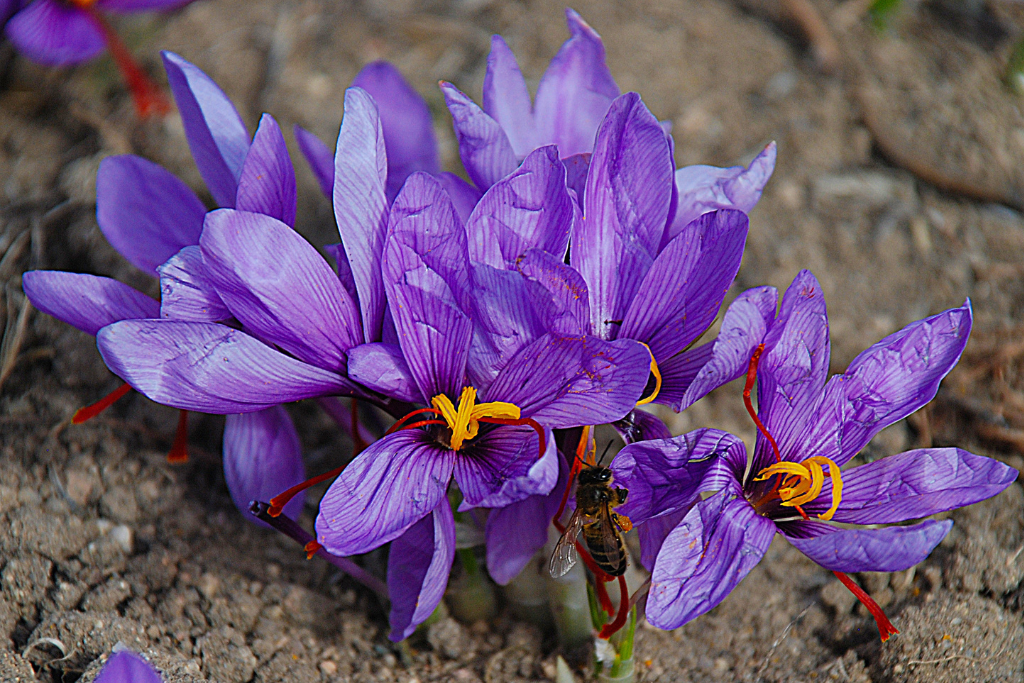Saffron, renowned as the world’s most expensive spice, is prized for its vibrant color, unique flavor, and medicinal properties.

Derived from the delicate threads of the Crocus sativus flower, saffron has been coveted for centuries by chefs, herbalists, and artisans alike.
While traditionally cultivated in regions with specific climatic conditions, it’s entirely possible to grow saffron at home, allowing enthusiasts to savor its exquisite qualities firsthand.
In this guide, we’ll explore the steps to successfully cultivate saffron in your own garden or indoor space, unlocking the secrets of this luxurious spice.
Selecting the Right Bulbs:
The first step in growing saffron is acquiring high-quality saffron corms, which are the bulb-like structures that produce the flowers. It’s essential to purchase corms from reputable suppliers to ensure viability and authenticity.
Opt for large, healthy corms with firm texture and no signs of mold or damage. Saffron corms are typically available for purchase in late summer or early fall, the ideal time for planting.
Choosing the Right Location:
Saffron thrives in well-drained soil and full sun, making it suitable for a variety of garden settings. Select a sunny spot in your garden or a location with at least six hours of direct sunlight per day.
Ensure that the soil is loose, sandy, and rich in organic matter to promote healthy growth.
If planting in containers, use a well-draining potting mix and place the pots in a sunny area, such as a patio or balcony.
Planting and Care:
Plant saffron corms in late summer or early fall, ideally around late August to early September, to allow them to establish before winter dormancy.
Dig shallow holes or trenches about 4-6 inches deep and space the corms 4-6 inches apart.
Place the corms with the pointed end facing upwards and cover them with soil, lightly pressing down to secure them in place.
Water thoroughly after planting and continue to water regularly, keeping the soil evenly moist but not waterlogged.
Harvesting Saffron:
Saffron flowers typically bloom in the fall, usually from late September to early November, depending on your location and climate.
Each flower produces three bright red stigmas, which are the prized saffron threads.
To harvest saffron, carefully pluck the stigmas from the flowers using tweezers or your fingers.
Handle the delicate threads with care to avoid damaging them. Once harvested, saffron threads can be dried and stored in an airtight container for future use in culinary or medicinal applications.
Overwintering:
After flowering, saffron plants enter a period of dormancy during the winter months. Mulch the soil around the plants to protect the corms from freezing temperatures and moisture loss.
In spring, as temperatures warm up, saffron plants will begin to sprout new foliage, signaling the start of a new growing season.
Resume regular watering and fertilize lightly with a balanced fertilizer to support growth and flowering.
Growing saffron at home is a rewarding endeavor that allows you to experience the magic of cultivating the world’s most expensive spice right in your own backyard or indoor space.

By following these simple steps and providing the right growing conditions, you can enjoy a bountiful harvest of saffron threads to elevate your culinary creations and enrich your life with the exquisite flavor and aroma of this precious spice.
So why not embark on the journey of growing saffron and add a touch of luxury to your home garden?
News
Courtney Roker surprised her father Al Roker with a mysterious Christmas gift, making him reconsider his future at TODAY: “It’s time to focus on family.”
The Christmas Gift That Sparked a Conversation Christmas is a season filled with surprises, and this year, it brought a heartfelt moment for the Roker family. Courtney Roker, daughter of the renowned Today Show host Al Roker, recently revealed the…
The View could be nearing its end as Elon Musk takes steps to acquire ABC, allegedly for revenge after being slandered on the show.
In recent weeks, a rumor has circulated that Elon Musk, the billionaire entrepreneur and CEO of Tesla and SpaceX, had purchased ABC and canceled the popular talk show The View. This claim quickly sparked widespread debate and confusion, with some…
SHOCK: The Masked Singer viewers left producers stunned by uncovering the identity of the Blowfish character from just one clue: the number 11.
The ITV hit show *The Masked Singer* is known for its wild costumes, surprising celebrity reveals, and nail-biting guessing games. However, during a recent episode, eagle-eyed fans quickly took to social media after the identity of one of the contestants,…
ITV bosses enraged viewers when the true motive behind their refusal to “unmask Pegasus’ singing voice” on The Masked Singer was revealed.
Fans of *The Masked Singer* were left disappointed and frustrated after the identity of the Pegasus character was revealed, with many viewers claiming that the reveal was far too obvious. The show, known for its elaborate costumes and mystery-solving intrigue,…
Host Joel Dommett angered fans of The Masked Singer by intentionally interfering to prevent a contestant from “removing their mask” during a live broadcast.
Viewers of ITV’s *The Masked Singer* UK were left shocked and frustrated when the popular show was unexpectedly halted for a special announcement during a live episode. In a move that has never happened before in the show’s history, the…
Fans of The Masked Singer erupted in anger after discovering the producers intentionally misled them about Spag Bol’s identity.
The Masked Singer, a show known for its dazzling costumes and unpredictable reveals, has once again sparked a heated debate among fans. This time, the controversy centers around a recent twist that many viewers are calling a “cop out.” Social…
End of content
No more pages to load











